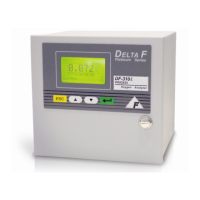Sample Gas Preparation and Delivery DF-310E 39
sample gas is a hydrocarbon, maintain the gas temperature 20° F to 40° F
above its dew point. In some applications, it may be necessary to chill the
sample gas before it enters the analyzer so that the hydrocarbons can be
condensed, collected, and removed. It is good practice to pitch the sample gas
lines to allow condensables to drain away from the analyzer. Gas sample
delivery lines that contain sample gases with high moisture content must not
be exposed to temperatures below the dew point.
6.4.2 Gas Solubility in Aqueous KOH Solution
Some sample gas constituents are soluble in the sensor’s potassium hydroxide
(KOH) electrolyte. Gases that are rated as “Soluble” to “Infinitely-Soluble”
may pose a threat to the sensor.
The sensor should have limited exposure (less than 1% by volume on a
continuous basis) to highly water soluble alcohols, such as methanol, and/or
be supplemented with periodic electrolyte changes to limit buildup within the
electrolyte.
Many gas species with infinite solubility in aqueous KOH (such as nitrous
oxide (N
2
O), however, do not affect the electrode or sealing materials, or
interfere with the O
2
reduction/oxidation reactions. Contact the local
Servomex Business Center for recommendations on a specific application.
6.4.3 Reactivity with KOH Electrolyte
Many process sample streams contain various concentrations of acid gases.
Acid gases are gases that react with the basic KOH electrolyte solution to
form a neutralized solution. The sensor does not operate properly when the
electrolyte solution is neutralized.
Besides a neutralization of the electrolyte, a base reactive sample gas may
have other negative effects, such as a base-catalyzed polymerization reaction.
The O
2
electrode reaction sites may become blocked by the polymerized
byproduct residue at the interface where the gas sample meets the electrolyte.
6.4.4 Flammable Sample Gas
There is nothing within the analyzer sample system that can ignite a
flammable sample gas. However, it is critical to ensure that the sample gas
does not escape from the sample system into the analyzer enclosure, or the
room, where ignition is possible. Stainless steel plumbing should be used
throughout the entire sample system if the sample gas is flammable.
Also, the analyzer enclosure can be purged with nitrogen, or the entire
Analyzer can be mounted in a purged enclosure, so that any sample gas that
escapes the plumbing is diluted.
6.4.5 Trace acids in the sample gas
With the STAB-EL Acid Gas system, oxygen measurements in sample gases
containing certain levels of acids are possible. Trace acids are common
byproducts of gas distribution system assembly and its accessories. Trace
acids can compromise the accuracy of the sensor and its construction if they
are not managed properly. See the section Stab-el Acid Gas System on page

